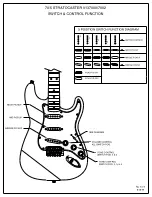
stewmac.com
5
Prep for finishing
Inspect the body and neck for any dents, chips, or other
imperfections and repair them. Small dents can be steamed
out by placing a damp cloth over the dent and applying
heat with a soldering iron. Chips, tear out, and knotholes
will need to be filled.
Sand the body and neck
Using 150-grit sandpaper on a flat sanding block, sand the
entire body working only in the direction of the grain.
After a complete sanding, wipe the body with a damp
cloth to raise the grain and reveal fibers that need more
sanding. Let the dampness dry, then sand the raised grain
with 220-grit sandpaper. After sanding, raise the grain again
and sand a third time, using 320-grit sandpaper. Follow the
same procedure with the neck, using care not to sand on
the fretboard face or frets.
Note that the peghead face is covered with a very thin ma-
hogany veneer. Very lightly sand with 320 using care not to
sand through.
Run your fingers along the edge of the fretboard and feel for
sharp fret ends. If the frets feel sharp where they meet the
edge of the neck, gently sand them back with long strokes
down the length of the neck. Use care not to change the
bevel of the frets in the process.
While sanding with 320-grit slightly break any sharp edges
on the fretboard body, fingerboard, and peghead. Soften-
ing hard edges promotes even finish coverage. Later, when
you’re finish sanding, these edges are less likely to sand
through to bare wood.
Degrease with naphtha
When you’ve finished sanding, wipe the body and neck with
a naphtha-dampened lint-free rag to remove any oils or
grease. From this point on, wear clean gloves when handling
so you won’t contaminate the wood.
Tape off the bridge and tailpiece bushings in the body, and
the string nut and fretboard face; they do not get filled or
finished.
Fill the grain
The body and neck of your guitar kit are made of mahogany,
which is an open grained wood. The grain will need to be
filled before finishing in order to achieve a flat surface.
We suggest using our ebony ColorTone Powdered Grain
Filler following the instructions on the label. 2-3 applications
are recommended to get a nice flat surface to build finish
coats over.
For more info on grain filling, see our article #i-0269 “Using
ColorTone Grain Filler” at stewmac.com.
stewmac.com
search:
i-0269
TIP!
Make holding handles for the neck and body. These can
be clamped in a vise or to a bench for filling and finishing,
a hanging hole can be added for drying. Nothing fancy,
scrap wood will do.
























